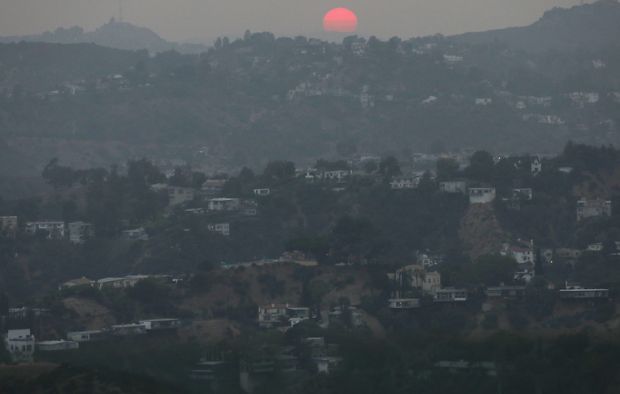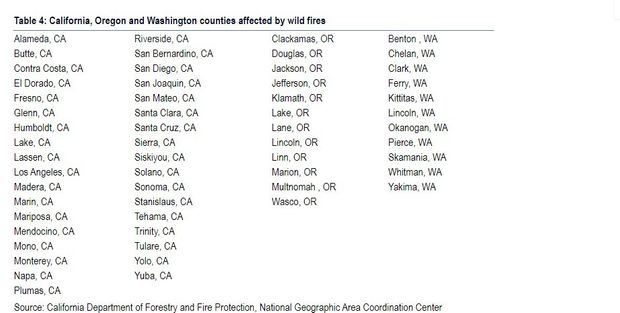
The sun sets in Los Angeles amid smoke from wildfires.
Mario Tama/Getty Images
Wildfires choking West Coast skylines with smoke and ash and burning more than 4 millions of acres already have put an estimated $120 billion worth of commercial properties at risk.
That’s the latest tally from analysts at BofA Global Research who looked at 58 counties in California, Oregon and Washington with ongoing wildfires and then cross referenced properties in those areas with debt that’s been packaged into commercial mortgage backed securities (CMBS), a popular form of property bonds.
It’s still too early to tell what the actual commercial property damage might be beyond the CMBS market or how much carnage could still occur. But this year’s fire season already has morphed into an unprecedented beast, one that an angry California Gov. Gavin Newsom on Friday called “a climate damn emergency.”
The threat of fires also are forecast to be a continuing issue in parts of California through October and November.
But at present, there is about $93 billion worth of CMBS debt on a mix of office buildings, hotels, shopping centers and multifamily properties at risk due to the fires, as well as a number of bonds exclusively tied to single buildings. BofA pegged another $27 billion worth of multifamily CMBS debt within the wildfire range that comes with partial government guarantees.
Here’s their list of counties with commercial properties in danger.

The team used data from the California Department of Forestry and Fire Protection and mapped towns in Oregon and Washington using information from the National Geographic Area Coordination Center.
Market concern around the fires appeared to ease Monday. U.S. stock indexes were shrugging off the West Coast carnage and climbing higher, with the Dow Jones Industrial Average DJIA, +1.36% up more than 300 points amid positive reports from several Covid-19 vaccination candidates.
A key question that has emerged is whether the wildfire damage can covered by insurance.
“The concise answer is that we aren’t 100% certain,“ wrote the BofA team led by Alan Todd, adding that his bank’s securitization group, or bankers that package and sell property debt into bonds, often to bond funds, insurance companies and the like, “is currently operating under the assumption that fire damage will be covered under ‘all-risk’ insurance.”
Todd further notes: “As we’ve found with other types of insurance, however, it will likely take months after claims are submitted to determine the scope of the damage; what exactly will be covered; how much insurance will be available and how quickly claims can be settled.”
Of note, their overview is limited to existing wildfires — from a single corner of property finance — not a full view as to what could be at stake for the roughly $4.5 trillion commercial property debt market due to climate change.
“Since the value of real estate is closely linked to the value of the land it is built on, physical risks, such as wildfires and rising sea levels, can directly affect real-estate prices,“ a task force for the U.S. Commodity Futures Trading Commission wrote last week on its first ever report on climate change and the U.S. financial system.
Read: Climate change is huge risk for the American financial system, a major new bipartisan report says
That report pegged about one-fifth of the near half trillion dollars worth of outstanding CMBS debt in the Bloomberg Barclays Aggregate Index AGG, -0.04% as underpinned by properties in “New York, Houston and Miami — cities that are highly vulnerable to climate change-exacerbated flooding because of sea-level rise and more intense storms.“
“The risks will likely rise,” the report said.





